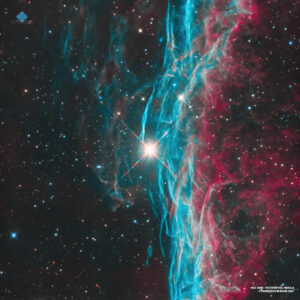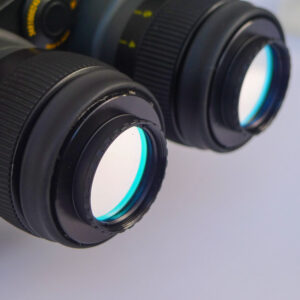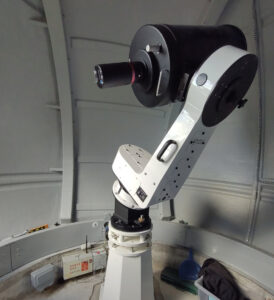Baader Planetarium Blog Posts
-
With the Baader M68-Tilter to perfect alignment
This entry was posted on January 17, 2022 Last modified on February 20, 2024.
The Baader M68 is a system that fulfils many wishes in an elegant way and with high stability. All distances can be set precisely, and with the Baader M68-Tilter (#2458170 , € 255,-) an ingenious extension has been added to the system. But before talking about the tilter, let me tell you how I came to this system. When I was testing the prototype of the Baader FCCT (Filter Changer Camera Tilter) for RASA 8" and QHY cameras (various versions available) for the RASA 8, I wished that the connection and collimation possibilities for the C14 were just as sophisticated. I have acquired enough experience so that I can "read" the image of the C14 so well that I know whether I am really seeing...
-
Upgrade of the Open University's COAST and PIRATE Telescopes on Tenerife
This entry was posted on November 24, 2021 Last modified on February 26, 2024.
The United Kingdom's Open University (OU) operates two robotic telescopes, along with an associated weather station and all sky camera, 2390m (7840ft) above sea level (and the clouds!) at the Instituto de Astrofísica de Canarias (IAC) Teide observatory on the Spanish island of Tenerife. Until mid July 2021 these two telescopes, called COAST and PIRATE, had the following telescope equipment setups: COmpletely Autonomous Service Telescope (COAST): Celestron C14 on a 10Micron GM4000, Baader Heavy Pier with FLI PL09000 camera and filterwheel and Baader filters all housed in a 3.5m Baader All-Sky Dome The Physics Innovations Robotic Telescope Explorer (PIRATE): PlaneWave CDK17 on a 10Micron GM4000 mount, Baader Heavy Pier with FLI PL16803 camera and FLI filterwheel and Baader filters in a Baader 4.5m diameter AllSky...
-
Test review: BAADER ULTRA NARROWBAND FILTER, Francesco di Biase
This entry was posted on December 1, 2021 Last modified on October 6, 2023.
Mr. Francesco di Biase had the opportunity to test the new Baader Ultra Narrowband Filters 36mm in unmounted version in his small observatory with a sliding roof under a suburban sky (19.40 SQM). Among other things, the observatory is equipped with a 10micron GM2000 HPS II mount and a 12" GSO RC telescope, which he uses at full focal length with a KAI 4022 CCD sensor. We are very pleased about the positive feedback on the new CMOS-optimized Baader 3.5 / 4nm Ultra-Narrowband Filter-Set – CMOS-optimized (H-alpha / O-III / S-II) (various versions available) and his field report. Original: My general opinion on performance, supported by the tests carried out and my experience with other high-end products, is fully positive. I believe that they can...
-
A report on visual use of the Baader H-Beta 5.5nm CMOS filter
This entry was posted on November 18, 2021 Last modified on October 6, 2023.
In the summer of 2021 I approached Baader Planetarium to ask whether I could test the new Baader O-III Narrowband-Filters (6.5nm) – CMOS-optimized (various versions available) to explore its visual capabilities for binocular observation of galactic nebulae. To my delight and surprise, Messrs. Baader offered not only to provide on loan the 6.5nm OIII Filter which I had requested, but also a prototype of the Baader H-Beta Narrowband-Filter (5.5nm) – CMOS-optimized (various versions available) now available on the market – and to do so in pairs in both 1.25” and 2” filter cells! I must admit that, initially, I had no particular expectations of the 5.5nm filter. For I, too, had allowed the prevailing myths about H-Beta obervation to cloud my view. These myths include:...
-
Tips for Choosing an Energy Rejection Filter for H-alpha-Observations
This entry was posted on November 17, 2021 Last modified on October 6, 2023.
The purpose of an Energy Rejection Filter is to prevent as much solar energy as possible from entering the telescope in the first place and thus avoid excessive heating of the etalon of an H-alpha filter. This is done most effectively by a filter in front of the telescope. At the same time, this prevents the air in the tube from heating up - the telescope remains close to the ambient temperature, and there are no air turbulences inside of the OTA due to temperature differences. If we look at the solar spectrum, it becomes clear that such a filter must primarily block visible light. Ideally, it reflects the solar energy energy instead of absorbing it and and does not heat itself up in the...
-
Now available: New Baader UBVRI and SLOAN/SDSS (ugriz') Photometric Filters
This entry was posted on October 12, 2021 Last modified on February 28, 2024.
Some things cannot be improved. You can only make them better. Filters for astrophotography are constantly being improved to adapt them to modern imaging systems and changing environmental conditions. Our CMOS-optimized narrowband filters are the best example for this development and research process. There are other demands for those filters which are used for science instead of pretty pictures: they must deliver data that are comparable even with decades-old data sets. New developments must therefore only improve production and handling without changing the filter characteristics themselves. The filters used today for scientific photometry with digital sensors go back to the filter sets introduced by Johnson and Cousins, which were developed in the 1950s-1970s and which were adapted in the 1990s by M. Bessel for CCD...
-
Alston Observatory's (University of Central Lancashire UK) New PlaneWave Installation - part one
This entry was posted on October 29, 2021 Last modified on October 6, 2023.
The Alston observatory is located in a rural area about 7 miles from the city of Preston in the north-west of England and is the undergraduate teaching and public outreach facility of the University of Central Lancashire's (UCLAN) Jeremiah Horrocks Institute for Astronomy, Maths and Physics. In 2015, we supplied and installed their PlaneWave Instrument (PWI) CDK700 – a 0.7m/27.5” aperture alt-azimuth state-of-the-art computerised robotic telescope. This telescope, named the Moses Holden Telescope (MHT), was their facility “centrepiece” and is one of the current largest modern robotic telescopes in the UK. You can view this telescope in an interactive 360 degree view on the University's FaceBook page and find out more about the installation on our observatory world map. In addition to this impressive telescope,...
-
Bayfordbury Observatory (University of Hertfordshire) UK PlaneWave CDK600 Installation
This entry was posted on October 29, 2021 Last modified on October 6, 2023.
The University of Hertfordshire's Bayfordbury observatory is primarily used for undergraduate tuition and is one of the largest teaching observatory facilities in the UK. It is located in relatively dark skies in the countryside about 6 outside the town of Hertford (about 30 miles north of central London) and includes seven optical telescopes permanently mounted in their own observatory, solar telescopes, four radio telescopes and some smaller instruments. Although primarily used for teaching, the observatory also run public outreach programmes too. More information on the courses offered and the activities of the observatory can be found here. We were honoured earlier this year to be chosen to supply and install a new addition to their optical telescope facilities to replace an older smaller telescope –...
-
Test review: Baader CMOS-optimized 5.5nm H-Beta Narrowband Filter
This entry was posted on November 2, 2021 Last modified on October 6, 2023.
Our customer Andreas Bringmann was one of our first testers of the new CMOS-optimized Baader Ultra-Highspeed F/2 filters. The all new f/2 Ultra-Highspeed Filters not only lead to amazing images but even enabled the photographic proof of the newly discovered planetary nebula StDr13, check out the detailed test review. Now Mr. Bringmann had the opportunity to test the new CMOS optimized Baader 5.5nm H-Beta filters: First of all, I would like to thank you very much for allowing me to test the new Baader filters and I can report that the new CMOS-optimized 5.5nm H-beta filter works photographically perfectly even at f/1.9! Andreas Bringmann, www.astrobin.com/equinoxx/ The new CMOS-optimized 5.5nm H-beta filter was compared against the old 8.5nm H-beta filter from 2014, which was in Mr....
-
New CMOS-optimized Baader Filters
This entry was posted on May 8, 2021 Last modified on February 28, 2024.
See results Here you can jump directly to customer images taken with CMOS-optimized Baader Filters Update May 4th, 2022: After many customer feedback about our CMOS-Optimized Narrowband filters, we learned that it is necessary to finetune our current f/2 Highspeed filters into two filter categories of Ultra-Highspeed filters for f/2 (working range <f/2.3) and – NEW – f/3 (working range f/2.3 to f/3.4). Further Information about this as well as a detailed whitepaper can be found in our Blogpost Preshift and further Information concerning Baader CMOS-Filters. Update October 1st: New LRGB-Filters have been added to the line of CMOS-optimized Baader Filters. The post below has been modified to reflect these changes. "Finding the way" has a long tradition at Baader Planetarium. The slogan got created...















